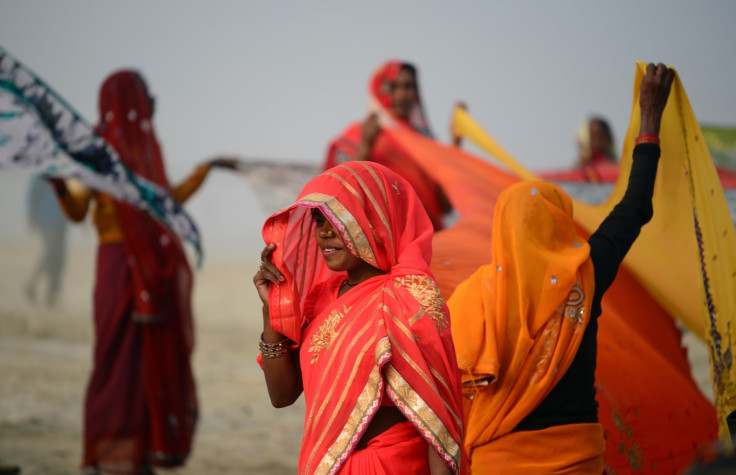The whole nine yards: The Indian sari is not a Hindu nationalist symbol despite the NYT's claim
A recent feature by the newspaper sparked a debate across India regarding the symbolism of the traditional garment.

The New York Times sparked a heated debate across India after one of its writers suggested that the sari was being used by the country's government to keep western cultural influences under check. Asgar Qadri, in his feature "In India, Fashion Has Become a Nationalist Cause", said that the traditional garment favoured by a large portion of the Indian female population was being aggressively promoted by the Prime Minister Narendra Modi-led government to further efforts to portray the country as "a Hindu nation".
Soon after the publication of the 12 November article, readers of the US news website voiced their criticism of the writer and his opinion, kicking off a Twitter campaign in support of the sari. Sanjeev Sanyal, economic advisor to the Modi government, turned sarcastic as he reacted to the article.
"@nytimes now thinks that wearing our traditional clothes is some sort of bigotry," he posted on Twitter. "Next up — eating dosa, biryani or chaat instead of hotdogs is unacceptable. Sickening attack on our way of life." Sanyal was referring to popular Indian meals and snacks.
Indian author Aruna Nambiar aired her issues with the story, which many also called "uninformed". "The sari is worn by women of all faiths," she mentioned in a social media post. "The resurgence of the sari is partly because of viral social media campaigns like the #100SareePact not Modi pleasing!"
What is a sari?
The traditional Indian garment for women is made up of three different pieces — the sari itself, which is a length of cloth measuring 42" to 49" wide and 5.5 to 9 yards; the blouse or 'choli' is generally a fitted top which ends above the midriff; and the 'petticoat' or skirt serves as a waistband to tuck the upper edge and pleats into, and as a slip to prevent the outfit from being see-through.
The basic wrap of a sari usually involves winding it around the waist first and then wrapping it around the upper body. There are many different styles of wrapping and draping the sari, and these vary according to region, social class, ethnic background and personal style.
Laila Tyabji, a social worker and designer, took the NYT story a notch down by sharing her experience of meeting the writer and suggested that he, like some other journalists, was in the "habit of pre-writing an article" and then "going looking for quotes to support their premise!"
"Asgar Qadri came to interview me for this piece and when he found I was saying exactly the opposite of what he wanted to hear, has wiped my views out of his article," she recalled, describing the religious aspect as "really rubbish".
"The traditional Indian clothes that Indians wear — the sari, salwar kameez, dhotis, lehenga ordni, the lungi and the mekala chador, sherwanis, achkans and Nehru jackets, have nothing to do with Hinduism!," Tyabji asserted.

In her view, the government was attempting to promote and revive the Indian handloom industry and not the traditional attire itself. "To conflate promotion of weaving or wearing handloom with a Hindu fundamentalist agenda is as absurd as saying that the fact that I, as a Muslim, have worn handloom saris on a daily basis all my adult life, reveals some hidden Hindutva connection!"
Bangladeshi author Taslima Nasreen, who describes herself as a secular humanist, also slammed the bias in the article. "I am not a Hindu. I am against all religious fundamentalism and nationalism. My favourite dress is sari. Bengali Muslim, Hindu, Buddhist, Christian, Atheist women's dresses are saris."
I am not a Hindu. I am against all religious fundamentalism and nationalism. My favourite dress is sari. Bengali Muslim, Hindu, Buddhist, Christian, Atheist women's dresses are saris.
— taslima nasreen (@taslimanasreen) November 15, 2017
While the sari may seem difficult to wear to a first-timer, women familiar with the garment describe it as feminine, comfortable and perfect for India's humid weather. "In India's highly unequal and stratified country, the sari is the most democratic clothing; it cuts across classes and castes, regions and religions, albeit with delightful variations in weave, fabric and style of draping," television journalist Barkha Dutt wrote in an op-ed for the Washington Post.
"It's also the most empowering to the female form; its one-size-fits-all style is wonderfully non-hierarchical about weight or body type."
A number of Christian convents have also ditched the Western-styled habit for the more conventional sari. Mother Teresa herself wore a white and blue sari during her life as a missionary.
"Saris were never about religion, they were about culture and tradition," former medical lecturer Francesca Gonsalves explained. Staff as well as students at the government-run King Edward Memorial Hospital Nursing College in Mumbai, where she worked, had a strict Indian dress code. "It looks elegant in a way a dress or trouser-suit cannot."






















